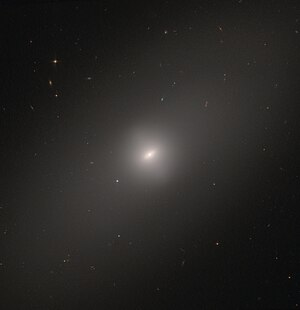NGC 3384
| Galaxy NGC 3384 |
|
|---|---|

|
|
| NGC 3384 as imaged by the Hubble Space Telescope | |
| AladinLite | |
| Constellation | lion |
|
Position equinox : J2000.0 , epoch : J2000.0 |
|
| Right ascension | 10 h 48 m 16.9 s |
| declination | + 12 ° 37 ′ 45 ″ |
| Appearance | |
| Morphological type | SB (s) 0-: |
| Brightness (visual) | 9.9 likes |
| Brightness (B-band) | 10.9 likes |
| Angular expansion | 5.4 ′ × 2.7 ′ |
| Position angle | 53 ° |
| Surface brightness | 12.9 mag / arcmin² |
| Physical data | |
| Affiliation |
M96 group LGG 217 |
| Redshift | 0.002442 ± 0.000117 |
| Radial velocity | 731 ± 35 km / s |
|
Stroke distance v rad / H 0 |
(27 ± 2) x 10 6 ly (8.32 ± 0.59) Mpc |
| history | |
| discovery | Wilhelm Herschel |
| Discovery date | March 11, 1784 |
| Catalog names | |
| NGC 3384, NGC 3371 • UGC 5911 • PGC 32292 • CGCG 066-021 • MCG + 02-28-012 • 2MASX J10481689 + 1237454 • GC 2207 • H I 18 • h 758 • spar 212B • PRC C-34 • LDCE 0778 NED010 | |
NGC 3371 = NGC 3384 is a lenticular galaxy in the constellation Leo on the ecliptic . It is an estimated 27 million light years from the Milky Way .
NGC 3384 is found together with Messier 105 and NGC 3389 in the same area of the sky and there form an optical triple. While NGC 3389 is a background object roughly twice that distance, the other two galaxies belong to the Leo group, 30 to 35 million light-years away . NGC 3384 is believed to be about 55,000 light years across.
The object was discovered on March 11, 1784 by Wilhelm Herschel . The catalog entry NGC 3371 , which goes back to an observation by John Herschel on March 23, 1830, probably also refers to this galaxy.
literature
- Meusinger, H .; Ismail, HA: "The inner structure of the S0 galaxy NGC 3384"; Astronomical News 328 (6), p. 562 (2007)
- Busarello et al .: "Yet another sub-component inside a bulge: the structure of the peculiar S0 galaxy NGC 3384"; Astronomy and Astrophysics 314, pp. 32-42 (1996)
Web links
- Spektrum.de : Amateur recordings [1]
- Spektrum.de: Map of the area
